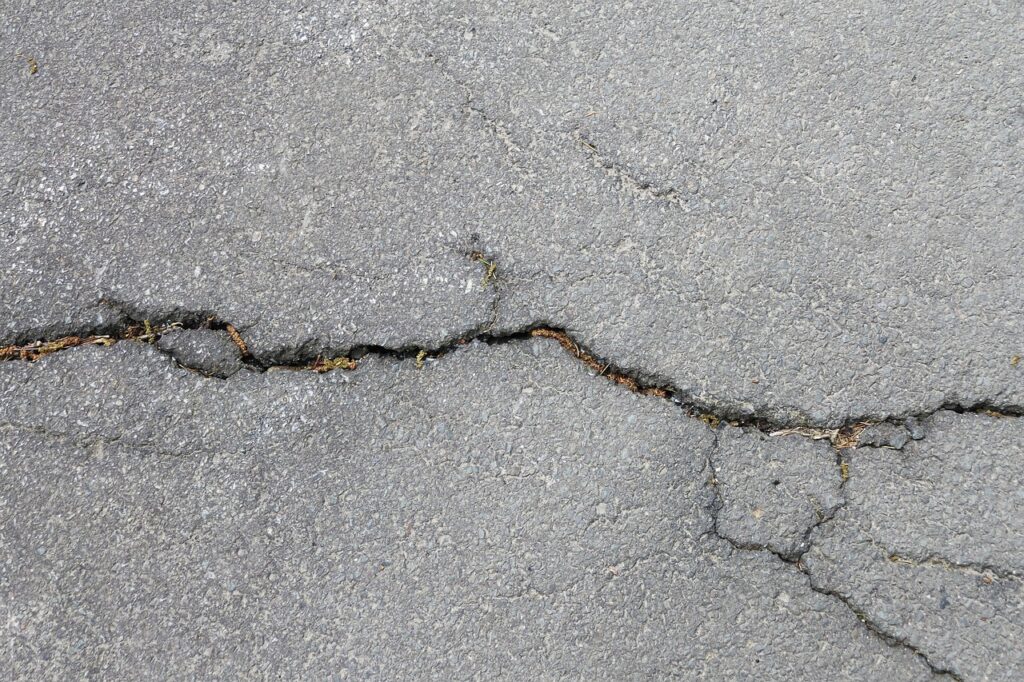One of my goals with these articles is to make them straight forward and easy to understand. This allows people with different backgrounds and experience levels to benefit from them.
Even with proper maintenance, your asphalt pavement will probably crack. Feel free to check out my other article that discusses the reasons why asphalt cracks. Crack sealing is one of the most cost-effective things someone can do to extend the life of your asphalt pavement. Doing it yourself can save you money. This article will provide you information on the supplies and tools needed to seal cracks.
Tools and materials needed
- Pressure Washer or Hose
- Air Compressor or Leaf Blower
- Screwdriver
- Wire Brush
- Quality Crack Sealer
- Metal Scraper
- Ribbon or Cones
Pressure Washer or Hose
One of the most important for crack sealing is making sure there isn’t a lot of dust/dirt in the crack. If the crack has dust in it, the crack sealer may not bond properly. This will reduce the life expectancy of the crack sealer. A pressure washer (recommended) or hose can remove the dust from the crack. Be careful that you don’t damage the asphalt with the pressure washer. The crack will need to be dry before applying the crack sealer.
Air Compressor or Leaf Blower
An air compressor or leaf blower is another way to remove dust from the crack. Using just an air compressor can speed up the process, no drying time required, but it may not get the crack as clean.
Screwdriver
A screwdriver is a great way to remove dirt and weeds from the crack.
Wire Brush
A wire brush is a great way to remove dust/dirt from the crack. Make sure you blow the crack out after using a wire brush.
Quality Crack Sealer
A quality crack sealer is critical if you want the product to last. A quality crack sealer should have more of the better ingredients (e.g. higher quality asphalt cement, polymers, fibers). These will probably cost more money, but they should be able to bond better and be able to expand/stretch more. You can buy a non-flowable crack sealer or a flowable sealer. Either one should work. Be careful with the flowable sealer because it is easy to apply too much sealer. Take your time until you get the hang of it.
Metal Scraper
A metal scraper may be needed if you buy a non-flowable crack sealer. You will use the scraper to smooth out the sealer.
Ribbon or Cones
Ribbon or cones is a good way to block off the areas that are crack sealed. Traffic shouldn’t drive over the sealer until it is set and cured. Make sure you follow the manufacturer’s recommendations.
The Process
You want to remove the dust/dirt from the crack and the surface of the asphalt pavement. The cleaner the asphalt is the better the crack sealer will stick/bond to the asphalt. I understand everyone is busy so you will have to decide how much time you want to take preparing the crack. At a minimum, I would recommend the following: 1) blow out the crack using an air compressor or leaf blower, 2) remove remaining dirt and weeds from crack using a screwdriver, 3) use a wire brush 4) blow out the crack again, 5) seal the crack with a quality sealer, 6) protect the crack sealer from traffic, and 7) allow the crack sealer to set and cure per the manufacturer’s recommendations.
Sealing Cracks
Take your time and don’t overfill the crack with sealer. Start in an area that most people won’t see. Start out slow and see how much the sealer spreads out. Remember, you can always go back and add more sealer if needed. Opinions vary on this, but I recommend trying to get a thin and narrow overlap (1/2″ on each side of the crack) or over band on the crack. I believe this helps keep more water out. Make sure the over band isn’t too thick, otherwise snowplows or snow blowers may catch it and remove the sealer from the crack. A metal scraper works well for creating the over band.
Cracks With Old Sealer
Preparing cracks that have already been sealed can take longer. The best option is to try to remove the old sealer, but if you don’t have time to do this then you can seal over the top of the existing sealer. You will probably have to create a wider over band to make sure the sealer is bonded to the asphalt. If you seal over the old crack sealer you may want to make sure the old sealer is still bonded (check bond with screwdriver) to the asphalt pavement. The crack sealer probably won’t last as long if you seal over the top of the existing sealer. Either option can work, and the important thing is to do the proper maintenance to keep water from entering the crack and deteriorating the pavement.
